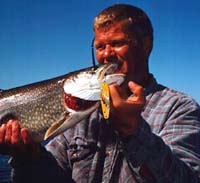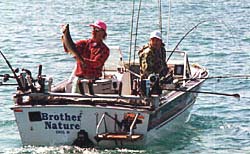|
|

|
 |
 | ||
Spoon Feed Lake Michigan
In early Spring the shoreline areas of Lake Michigan team with fish. Itís party time for easy fishing. After the alewife and smelt spawn, however, and the near shore shallows warm to 50 degrees, the food fish leave and thereís nothing anchoring gamefish to the area. This gives fishermen a new set of rules. Where the fish go is no mystery. They head off shore to where their food supply has moved. Many anglers quit fishing then, thinking the fish are too scattered to catch, or too far out in the lake for them to safely venture. Anglers who follow the offshore movement and adapt to the tactical changes needed for success often find fast fishing for cohos, kings and steelhead with bonus lunker lake trout, a species seldom encountered in the near shore season. Lures That Work
Full-bodied lures have the advantage of seducing browns and steelhead as well. On the seemingly rare occasions when calm winds allow near shore waters to clear, spoons take good numbers of fish. Miles out in the lake, the effects of onshore winds are nil and the water is perpetually clear. In these locations spoons reign king. Lure ColorSpoons are the premier lure offshore because they are highly visible. So it makes sense that the color of the spoon is an important consideration. Take a look in any successful Great Lake fishermanís tackle box and you will see spoons in a rainbow of colors. Lure color is important for several reasons. Certain colors are highly visible, since some colors imitate natural foods, and other colors, though unnatural, are appetizing to fish and may produce a striking reflex. In clear offshore waters high-vis colors such as fluorescent chartreuse and hot orange arenít needed to insure visibility, but they are often effective since they stimulate strikes. Cohos and steelhead seem to view fluorescent orange as I view chocolate covered cherries Ö irresistible. Chinooks seem to favor fluorescent green or chartreuse lures almost as much. Water filters out light of certain colors in the order they appear in a rainbow: red, orange, yellow, green, blue, indigo and violet. At 15-25 feet, there is no more red; at 25-40 feet orange fades to brown. Yellow disappears next and becomes nothing more than dull gray. By the time a lure gets down in 75-100 feet of water, where late June lake trout lurk, only the green, blue and violet part of the spectrum is left which explains why those colors are productive down deep. Alewives, thin, silvery fish are the predominant bait fish available offshore. As a result, thin, silver spoons are perfect alewife imitators. Even on a dark day, or down deep where light penetration is reduced, a silver or chrome-plated spoon is a good choice. Black spoons often work well, too. Most fish strike from below and against the skylight from above. The silhouette of a black lure often makes it the most visible color of all. At times, a solid color spoon, all green, all silver, all black, will work, but it seems a spoon which sports a contrasting highlight color works better. Silver/green, silver/blue, and black/violet are favorite combinations and donít forget hot orange in concert with black, gold, silver or chartreuse for those cohos and steelhead. They have color contrast built-in. Lure SpeedThere are many brands of spoons on the market which come in a variety of sizes and shapes. Any will work, if, a big if, if they have the proper action. Perhaps no one factor is as critical to a spoonís action as trolling speed. Some spoons work at slow speeds, but boost the troll speed a little and the snappy wobble that salmon and trout key on becomes a spinning line-twister, unlikely to catch anything. (Use of a ball bearing snap swivel helps avoid this.) Other spoons glide listlessly through the water at slower speeds but will troll great when the speed is boosted. Only a few brands run at a wide range of speeds. Always test a spoon next to the boat to insure itís action is compatible with the boatís speed. If the spoon spins out from going too fast or doesnít swim at all from lack of speed, either adjust the rate of travel or change to a spoon which works at the speed being trolled. Unlike fishing near the shore, where beaches, break walls and shoreline buildings can be used to pinpoint oneís location, miles out in the lake, it all looks the same. Though itís arguable whether salmon and trout form true schools, they do aggregate. When one is fish is found, there are likely to be dozens more, perhaps hundreds or thousands. The conditions which attract the first one invariably attract others. The key is to find the fish and stick with them. Use a Loran or GPS navigation system to record a way point and to stay with a group of fish. An inexpensive trick if you donít have a Loran is to fill a bright plastic jug about 1/3 full of sand and toss it out whenever a strike occurs. Depending on the wind, the jug will drift away eventually, but not until several passes through the area are made. Even then itís a simple matter to pick up the jug, troll directly into the wind and toss it out again when the fish-filled area is relocated. Spring and summer days with light winds and a stable forecast are good days to head for the offshore areas where Lake Michiganís fish are biting. Out there, the action is likely to be at its very best when you carefully spoon feed the salmon and trout. An America Outdoors Feature. All Rights Reserved. |
|
|
| Site design by Outdoor Management Network Inc. Copyright © 1996 - 2007 Outdoor Management Network Inc. America Outdoors® is a registered trademark of Outdoor Management Network Inc. |
 After the Spring flurry ends, move offshore to take limits of salmon and trout.
After the Spring flurry ends, move offshore to take limits of salmon and trout. A variety of lures are standard fare for near shore salmon and trout. Dodgers and flies are hot tickets for exciting coho action; so too are a variety of plugs, from small crankbaits to smelt-imitating stick-minnows.
A variety of lures are standard fare for near shore salmon and trout. Dodgers and flies are hot tickets for exciting coho action; so too are a variety of plugs, from small crankbaits to smelt-imitating stick-minnows.